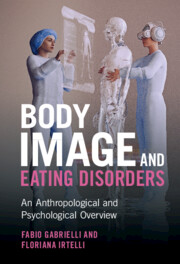Book contents
- Body Image and Eating Disorders
- Body Image and Eating Disorders
- Copyright page
- Contents
- Acknowledgments
- Part I Contemporary Perspectives in Anthropology, Philosophy, and Psychology on the Human Body: An Introductory Overview
- Part II Brain without Body, Body without Brain, and Contemporary Body Image Disorders
- Part III The Hypermodern Contradictory Relationship with Food
- 6 Contemporary Social Trends Regarding Food: Paradoxes and Food Tribes
- 7 A New Disorder: Orthorexia
- 8 Contemporary Perspectives on Anorexia
- 9 Nervous Bulimia and Binge Eating Disorder
- 10 Contemporary Perspectives on Obesity
- Part IV Which Possible Horizons? Some Final Considerations
- References
- Index
10 - Contemporary Perspectives on Obesity
from Part III - The Hypermodern Contradictory Relationship with Food
Published online by Cambridge University Press: 26 May 2022
- Body Image and Eating Disorders
- Body Image and Eating Disorders
- Copyright page
- Contents
- Acknowledgments
- Part I Contemporary Perspectives in Anthropology, Philosophy, and Psychology on the Human Body: An Introductory Overview
- Part II Brain without Body, Body without Brain, and Contemporary Body Image Disorders
- Part III The Hypermodern Contradictory Relationship with Food
- 6 Contemporary Social Trends Regarding Food: Paradoxes and Food Tribes
- 7 A New Disorder: Orthorexia
- 8 Contemporary Perspectives on Anorexia
- 9 Nervous Bulimia and Binge Eating Disorder
- 10 Contemporary Perspectives on Obesity
- Part IV Which Possible Horizons? Some Final Considerations
- References
- Index
Summary
This chapter attempts to answer some specific questions: Which is the cause of obesity? How does it relate to body image? How does obesity impact on personal identity? How does the situation vary according to gender? How does this condition vary in relation to age range? How does the family dynamic affect this condition? During this excursus many other interesting facts emerge, such as the statistic that only 10% of obese or overweight people are actually dieting, whereas nearly 20% of the rest of the population are trying to lose weight, even if they do not really need to. It is one of the paradoxes of the current era and one that affects mainly industrialized countries. Specific theories, scientific studies, and clinical examples are presented.
- Type
- Chapter
- Information
- Body Image and Eating DisordersAn Anthropological and Psychological Overview, pp. 112 - 122Publisher: Cambridge University PressPrint publication year: 2022

